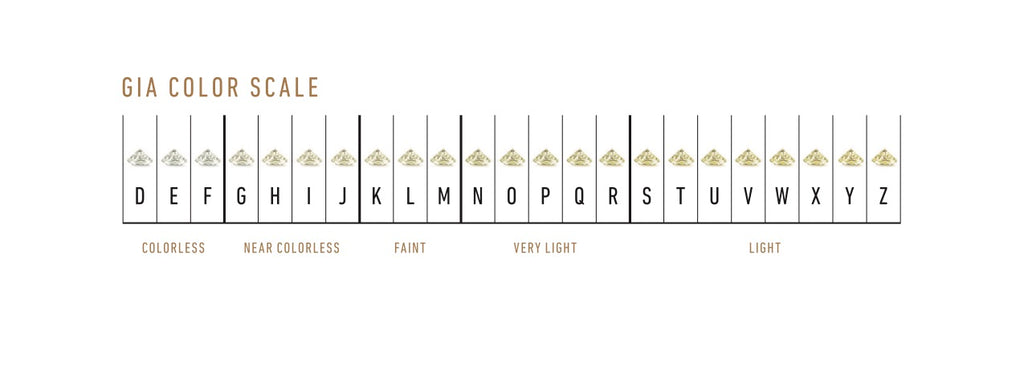Diamond Buying Guide
Diamond is a mineral composed of carbon and is the hardest material on this planet. The name comes from the Greek word ‘adamas’ meaning “a substance that is of exceptional hardness and is indestructible”. Diamonds were seen as the tears of God in Greek mythology. In some cultures they were thought to be the splinters of stars that had fallen on Earth.
It was believed that when worn on the left side of the body, a Diamond would protect its wearer from evil. This is perhaps why a Diamond is traditionally a popular choice for an engagement ring.
Diamonds are the most prized and valued of all gemstones because of their exceptional lustre, beauty, durability and rarity.
Diamond is the birthstone for April.
How are Diamonds valued?
A Diamond’s value is determined by four characteristics, known as the 4 C's, as explained in the video below.
Colour
Diamonds are graded for their colour. In most cases they are graded for their lack of body colour or degree of colourlessness or whiteness. The Gemological Institute of America (G.I.A) is a laboratory which devised a scale that starts with the letter D and ends with the letter Z, where D is an exceptional white and Z is a tinted yellowish colour.

The GIA colour scale helps to establish the price for a Diamond. For example, if carat and clarity are kept constant and the Diamond is a D colour, the D colour would be more expensive than other colours as the colourlessness is a rarer, desirable and more valuable trait.

Some Diamonds can be found in nature as a defined colour and thus are known as fancy coloured Diamonds. These Diamonds are not graded by the D-Z scale and are prized and valued for their depth of colour rather than their lack of colour. Red Diamonds are the rarest colour and most valuable fancy Diamonds. Fancy coloured Diamonds come in a variety of colours such as yellow, pink, blue, green, champagne and red. Within these colours different depths of a particular colour exist, e.g. with yellow Diamond you may find some come in light colour, others in intense and few in vivid. The vivid ones are the most prized as they are the rarest and most expensive.

Clarity
Clarity refers to the lack of marks or imperfections when examined or viewed under 10x magnification on the surface or inside the Diamond. Some internal features are minute traces of non-crystallised carbon or small Diamond colourless crystals. No two Diamonds will have inclusions in the exact same places despite their carat weight, colour or measurements being the same because these inclusions are nature’s fingerprint, thus enabling to identify each Diamond uniquely.

GIA devised a scale that starts with Flawless and ends at Imperfect where Flawless has no inclusions or blemishes whatsoever ( i.e. the cleanest stone possible in a Diamond) when viewed under 10x magnification and imperfect has highly noticeable inclusions and blemishes visible to the naked eye which highly impacts transparency and brilliance. This scale helps to price a Diamond. The lower down the scale you go towards Imperfect, the further the value of the Diamond depreciates (provided the other variants are the same).

Cut
The cut of a Diamond constitutes three key elements. First is its shape which is the stone’s outline alongside its distribution of facets.

Second is, the proportions of the stone.

Lastly the cut of a Diamond examines its finish, meaning the preciseness of its shape and how its facets have been arranged and placed. If a Diamond is poorly cut the stone may appear lifeless and dull (shallow cut) or black in the centre (deep cut) because the ray of light which enters the stone leaks out through the sides and base of the Diamond. However, a well cut stone or one cut to ideal proportions will allow rays of light from all sides to bend towards the middle of the stone and are reflected back through the top in a rainbow blaze (spectral colours) of light, maximising the Diamond sparkle.
The GIA institution has defined a cut grade standard only for the round brilliant cut Diamond as it is the most popular cutting style. The grades are shown below.

When valuing three round brilliant cut Diamonds of the same carat weight, colour and clarity but cut differently; if one was shallow (so looks bigger), the other was deep (so appears smaller) and one was well cut to ideal proportions. In this scenario the ideal cut Diamond is the most valuable as it has been manufactured to a higher standard thus produces more sparkle.

From left to right, the above photograph shows an excellent cut Diamond, followed by a good cut and then a poor cut.
Carat weight
Carat weight is a unit of measure by which Diamonds are weighed, where 1 carat is equal to 0.2 gram. The word carat derives its name from the locust tree (also known as carob) which is found in the islands of the Mediterranean because the seeds have a consistent weight of 0.2 gram.
A single round brilliant cut Diamond is more valuable than multiple smaller Diamonds whose combined weight is the same. This is because smaller Diamonds are easier to find in nature. As the Diamond gets larger in size there is a more disproportionate increase in cost per carat.
